Analyzing Multicultural Diversity in Australian Universities & Orgs
VerifiedAdded on 2022/11/28
|17
|4068
|273
Report
AI Summary
This report provides an in-depth analysis of multicultural diversity within Australian universities and organizations. It begins with an executive summary outlining the scope and objectives of the research, including the problem statement, aims, and objectives, research justification, and potential outputs. The report then delves into the conceptual framework, exploring the policies and practices of universities like Victoria University, the University of Queensland, and the University of Sydney in promoting a culturally diverse environment. A detailed methodology section explains the data collection methods, including qualitative and quantitative approaches such as surveys and interviews. The report examines cultural differences, linguistic diversity, and the impact of multiculturalism on student experiences, staff training, and organizational policies. The findings highlight the importance of creating inclusive environments, addressing potential challenges, and promoting intercultural understanding. The report concludes with recommendations for enhancing multiculturalism in Australian universities and organizations, supported by a comprehensive reference list.
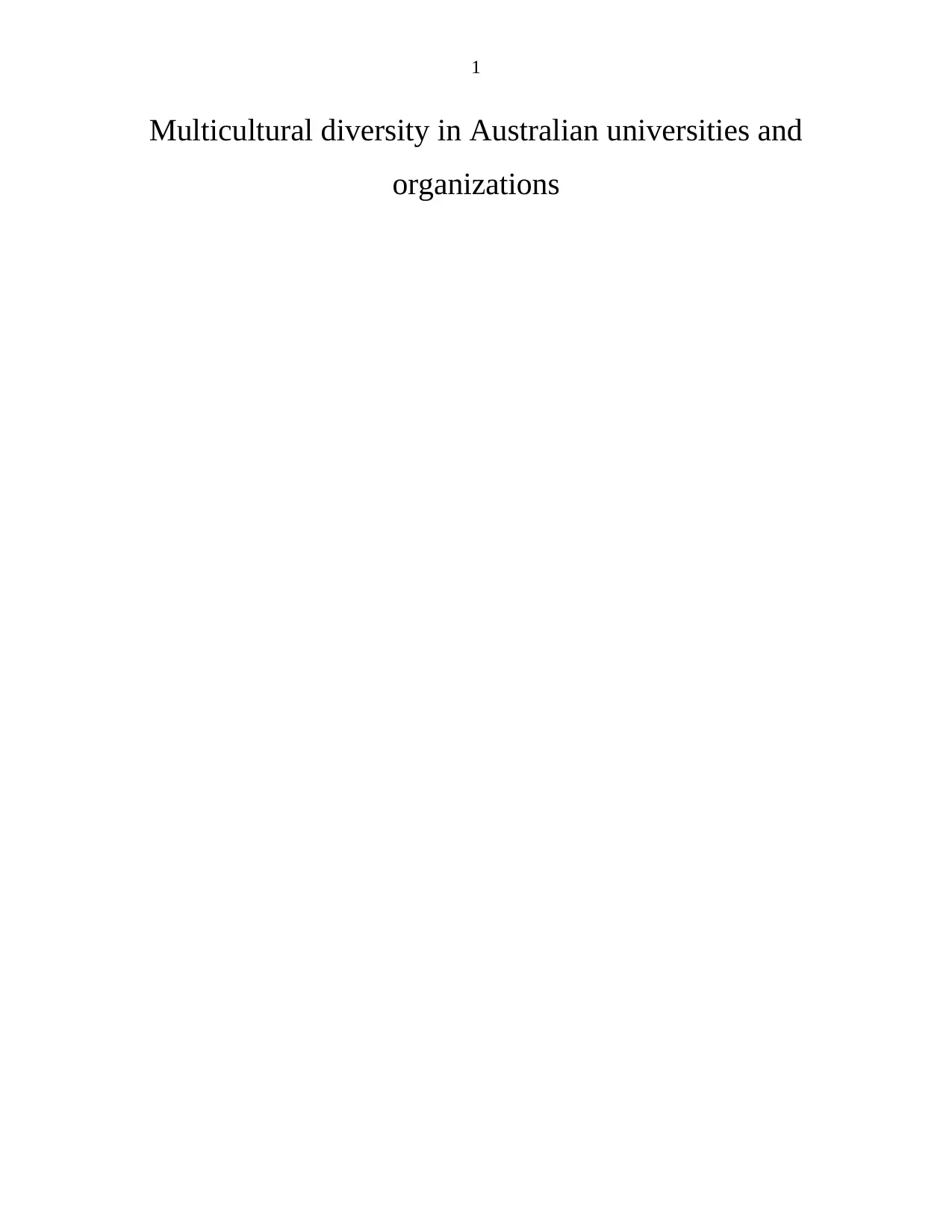
1
Multicultural diversity in Australian universities and
organizations
Multicultural diversity in Australian universities and
organizations
Paraphrase This Document
Need a fresh take? Get an instant paraphrase of this document with our AI Paraphraser
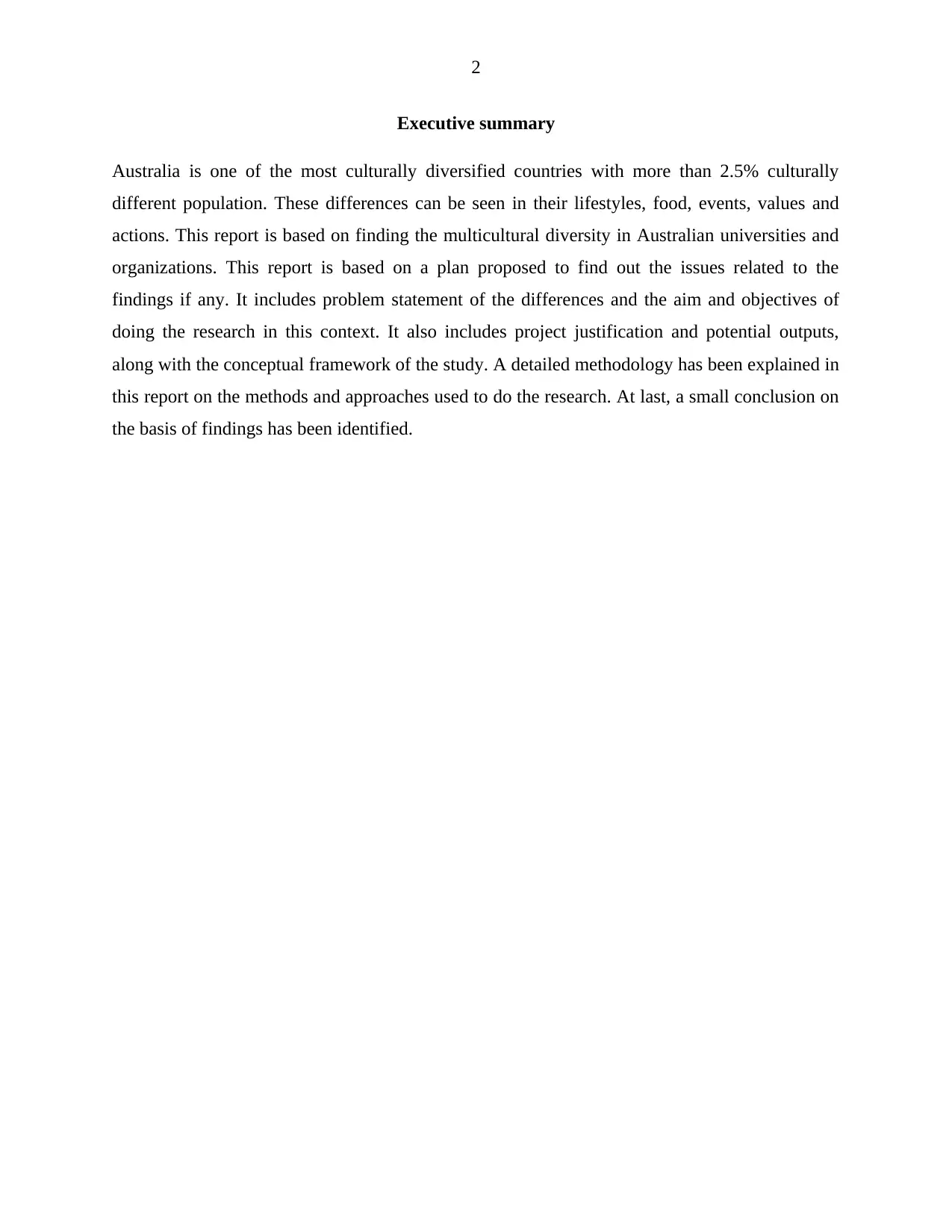
2
Executive summary
Australia is one of the most culturally diversified countries with more than 2.5% culturally
different population. These differences can be seen in their lifestyles, food, events, values and
actions. This report is based on finding the multicultural diversity in Australian universities and
organizations. This report is based on a plan proposed to find out the issues related to the
findings if any. It includes problem statement of the differences and the aim and objectives of
doing the research in this context. It also includes project justification and potential outputs,
along with the conceptual framework of the study. A detailed methodology has been explained in
this report on the methods and approaches used to do the research. At last, a small conclusion on
the basis of findings has been identified.
Executive summary
Australia is one of the most culturally diversified countries with more than 2.5% culturally
different population. These differences can be seen in their lifestyles, food, events, values and
actions. This report is based on finding the multicultural diversity in Australian universities and
organizations. This report is based on a plan proposed to find out the issues related to the
findings if any. It includes problem statement of the differences and the aim and objectives of
doing the research in this context. It also includes project justification and potential outputs,
along with the conceptual framework of the study. A detailed methodology has been explained in
this report on the methods and approaches used to do the research. At last, a small conclusion on
the basis of findings has been identified.
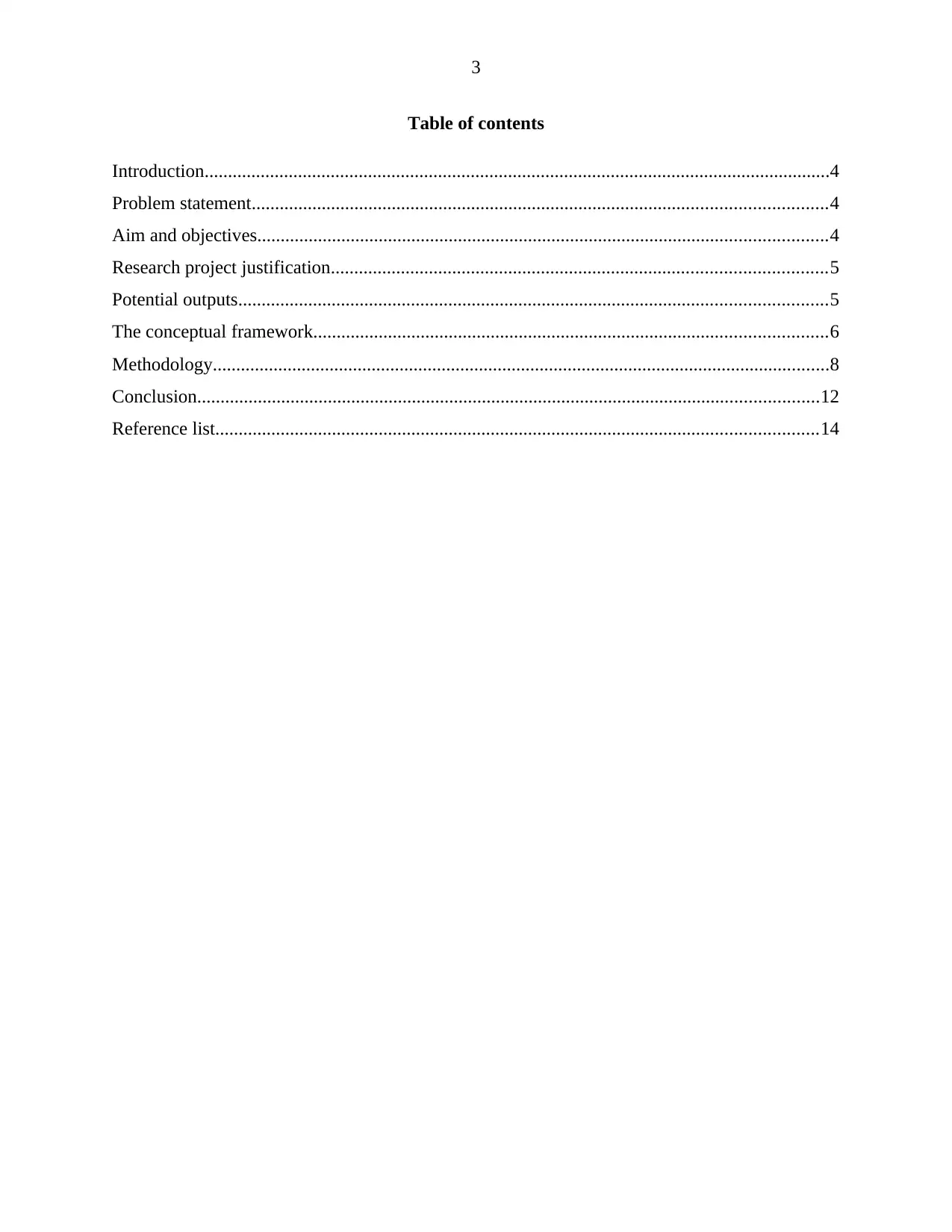
3
Table of contents
Introduction......................................................................................................................................4
Problem statement...........................................................................................................................4
Aim and objectives..........................................................................................................................4
Research project justification..........................................................................................................5
Potential outputs..............................................................................................................................5
The conceptual framework..............................................................................................................6
Methodology....................................................................................................................................8
Conclusion.....................................................................................................................................12
Reference list.................................................................................................................................14
Table of contents
Introduction......................................................................................................................................4
Problem statement...........................................................................................................................4
Aim and objectives..........................................................................................................................4
Research project justification..........................................................................................................5
Potential outputs..............................................................................................................................5
The conceptual framework..............................................................................................................6
Methodology....................................................................................................................................8
Conclusion.....................................................................................................................................12
Reference list.................................................................................................................................14
⊘ This is a preview!⊘
Do you want full access?
Subscribe today to unlock all pages.

Trusted by 1+ million students worldwide
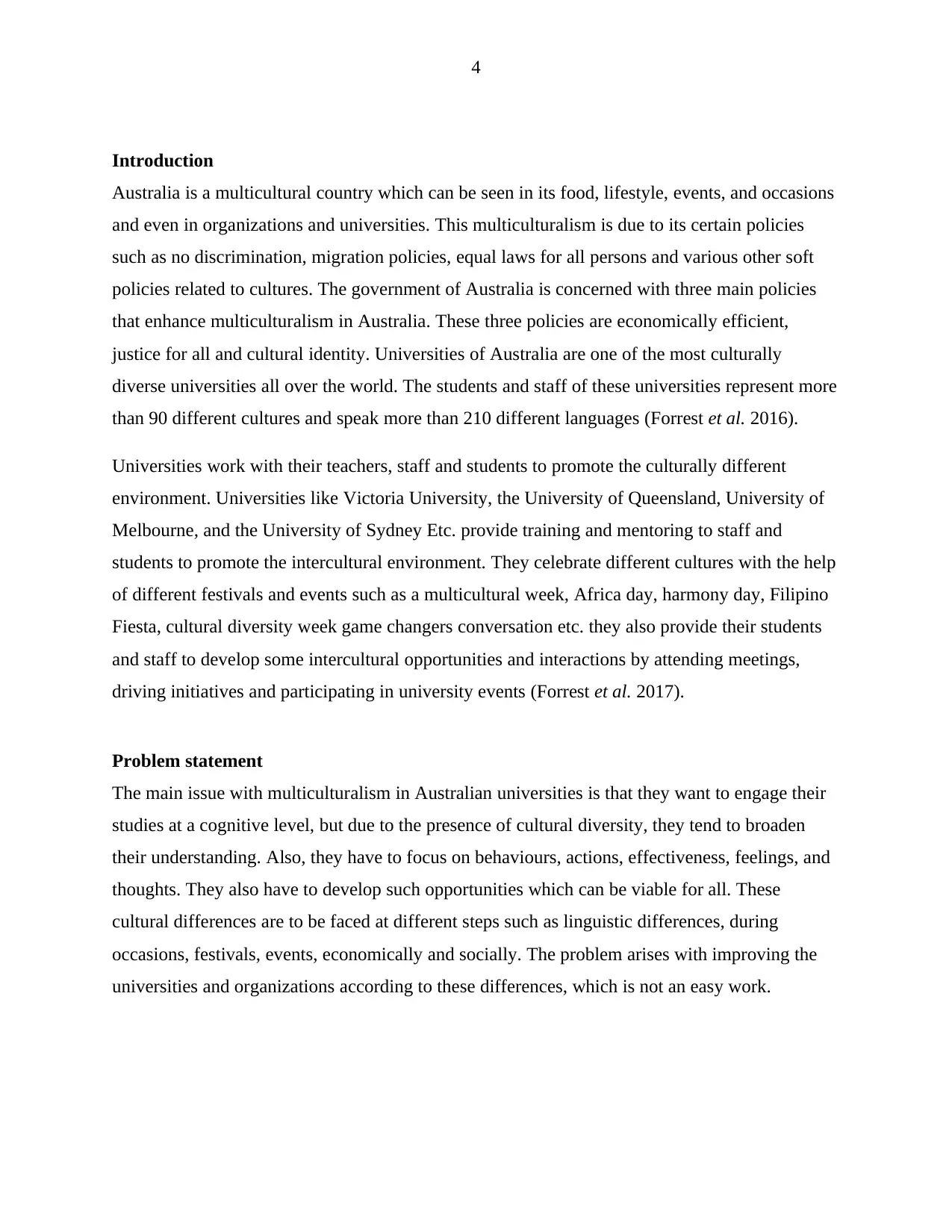
4
Introduction
Australia is a multicultural country which can be seen in its food, lifestyle, events, and occasions
and even in organizations and universities. This multiculturalism is due to its certain policies
such as no discrimination, migration policies, equal laws for all persons and various other soft
policies related to cultures. The government of Australia is concerned with three main policies
that enhance multiculturalism in Australia. These three policies are economically efficient,
justice for all and cultural identity. Universities of Australia are one of the most culturally
diverse universities all over the world. The students and staff of these universities represent more
than 90 different cultures and speak more than 210 different languages (Forrest et al. 2016).
Universities work with their teachers, staff and students to promote the culturally different
environment. Universities like Victoria University, the University of Queensland, University of
Melbourne, and the University of Sydney Etc. provide training and mentoring to staff and
students to promote the intercultural environment. They celebrate different cultures with the help
of different festivals and events such as a multicultural week, Africa day, harmony day, Filipino
Fiesta, cultural diversity week game changers conversation etc. they also provide their students
and staff to develop some intercultural opportunities and interactions by attending meetings,
driving initiatives and participating in university events (Forrest et al. 2017).
Problem statement
The main issue with multiculturalism in Australian universities is that they want to engage their
studies at a cognitive level, but due to the presence of cultural diversity, they tend to broaden
their understanding. Also, they have to focus on behaviours, actions, effectiveness, feelings, and
thoughts. They also have to develop such opportunities which can be viable for all. These
cultural differences are to be faced at different steps such as linguistic differences, during
occasions, festivals, events, economically and socially. The problem arises with improving the
universities and organizations according to these differences, which is not an easy work.
Introduction
Australia is a multicultural country which can be seen in its food, lifestyle, events, and occasions
and even in organizations and universities. This multiculturalism is due to its certain policies
such as no discrimination, migration policies, equal laws for all persons and various other soft
policies related to cultures. The government of Australia is concerned with three main policies
that enhance multiculturalism in Australia. These three policies are economically efficient,
justice for all and cultural identity. Universities of Australia are one of the most culturally
diverse universities all over the world. The students and staff of these universities represent more
than 90 different cultures and speak more than 210 different languages (Forrest et al. 2016).
Universities work with their teachers, staff and students to promote the culturally different
environment. Universities like Victoria University, the University of Queensland, University of
Melbourne, and the University of Sydney Etc. provide training and mentoring to staff and
students to promote the intercultural environment. They celebrate different cultures with the help
of different festivals and events such as a multicultural week, Africa day, harmony day, Filipino
Fiesta, cultural diversity week game changers conversation etc. they also provide their students
and staff to develop some intercultural opportunities and interactions by attending meetings,
driving initiatives and participating in university events (Forrest et al. 2017).
Problem statement
The main issue with multiculturalism in Australian universities is that they want to engage their
studies at a cognitive level, but due to the presence of cultural diversity, they tend to broaden
their understanding. Also, they have to focus on behaviours, actions, effectiveness, feelings, and
thoughts. They also have to develop such opportunities which can be viable for all. These
cultural differences are to be faced at different steps such as linguistic differences, during
occasions, festivals, events, economically and socially. The problem arises with improving the
universities and organizations according to these differences, which is not an easy work.
Paraphrase This Document
Need a fresh take? Get an instant paraphrase of this document with our AI Paraphraser
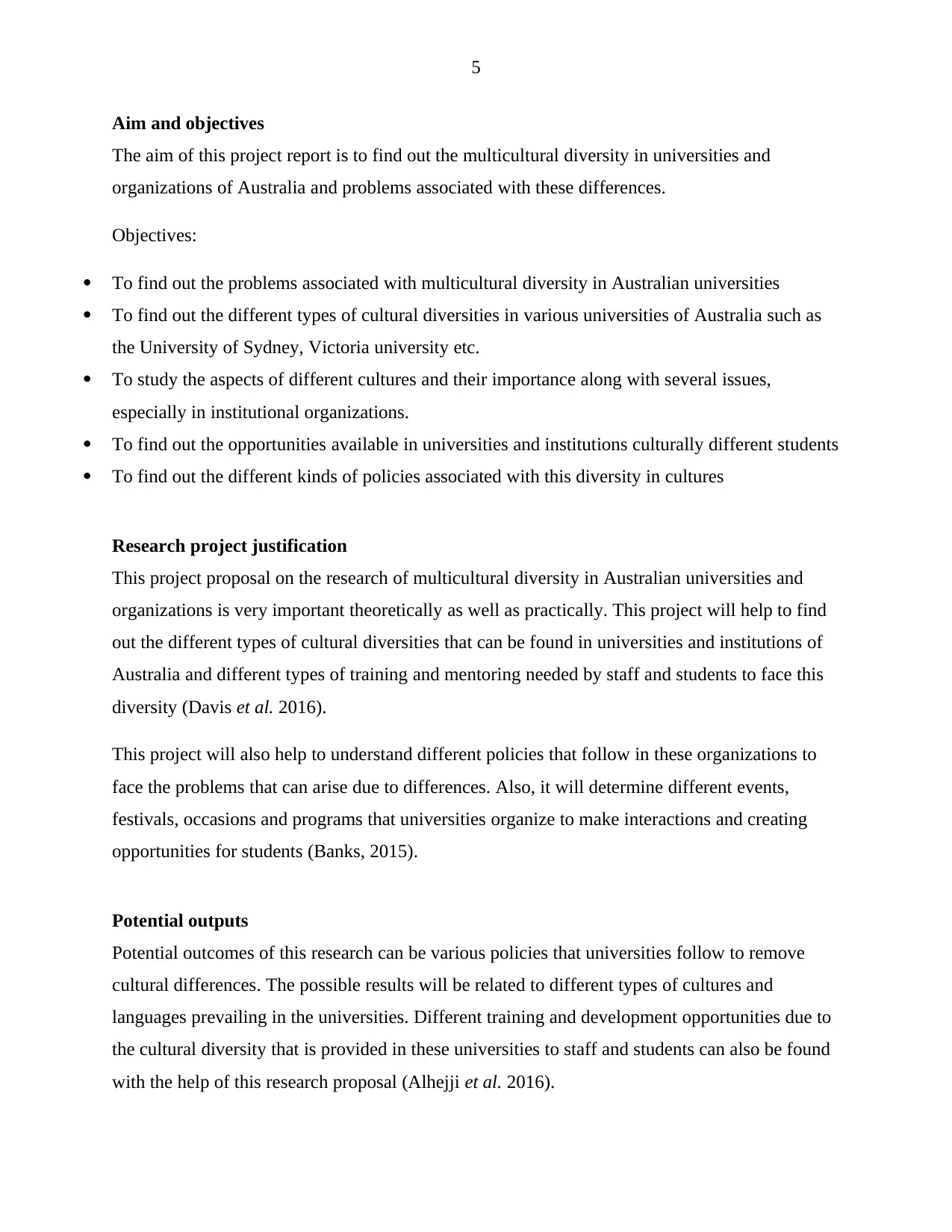
5
Aim and objectives
The aim of this project report is to find out the multicultural diversity in universities and
organizations of Australia and problems associated with these differences.
Objectives:
To find out the problems associated with multicultural diversity in Australian universities
To find out the different types of cultural diversities in various universities of Australia such as
the University of Sydney, Victoria university etc.
To study the aspects of different cultures and their importance along with several issues,
especially in institutional organizations.
To find out the opportunities available in universities and institutions culturally different students
To find out the different kinds of policies associated with this diversity in cultures
Research project justification
This project proposal on the research of multicultural diversity in Australian universities and
organizations is very important theoretically as well as practically. This project will help to find
out the different types of cultural diversities that can be found in universities and institutions of
Australia and different types of training and mentoring needed by staff and students to face this
diversity (Davis et al. 2016).
This project will also help to understand different policies that follow in these organizations to
face the problems that can arise due to differences. Also, it will determine different events,
festivals, occasions and programs that universities organize to make interactions and creating
opportunities for students (Banks, 2015).
Potential outputs
Potential outcomes of this research can be various policies that universities follow to remove
cultural differences. The possible results will be related to different types of cultures and
languages prevailing in the universities. Different training and development opportunities due to
the cultural diversity that is provided in these universities to staff and students can also be found
with the help of this research proposal (Alhejji et al. 2016).
Aim and objectives
The aim of this project report is to find out the multicultural diversity in universities and
organizations of Australia and problems associated with these differences.
Objectives:
To find out the problems associated with multicultural diversity in Australian universities
To find out the different types of cultural diversities in various universities of Australia such as
the University of Sydney, Victoria university etc.
To study the aspects of different cultures and their importance along with several issues,
especially in institutional organizations.
To find out the opportunities available in universities and institutions culturally different students
To find out the different kinds of policies associated with this diversity in cultures
Research project justification
This project proposal on the research of multicultural diversity in Australian universities and
organizations is very important theoretically as well as practically. This project will help to find
out the different types of cultural diversities that can be found in universities and institutions of
Australia and different types of training and mentoring needed by staff and students to face this
diversity (Davis et al. 2016).
This project will also help to understand different policies that follow in these organizations to
face the problems that can arise due to differences. Also, it will determine different events,
festivals, occasions and programs that universities organize to make interactions and creating
opportunities for students (Banks, 2015).
Potential outputs
Potential outcomes of this research can be various policies that universities follow to remove
cultural differences. The possible results will be related to different types of cultures and
languages prevailing in the universities. Different training and development opportunities due to
the cultural diversity that is provided in these universities to staff and students can also be found
with the help of this research proposal (Alhejji et al. 2016).
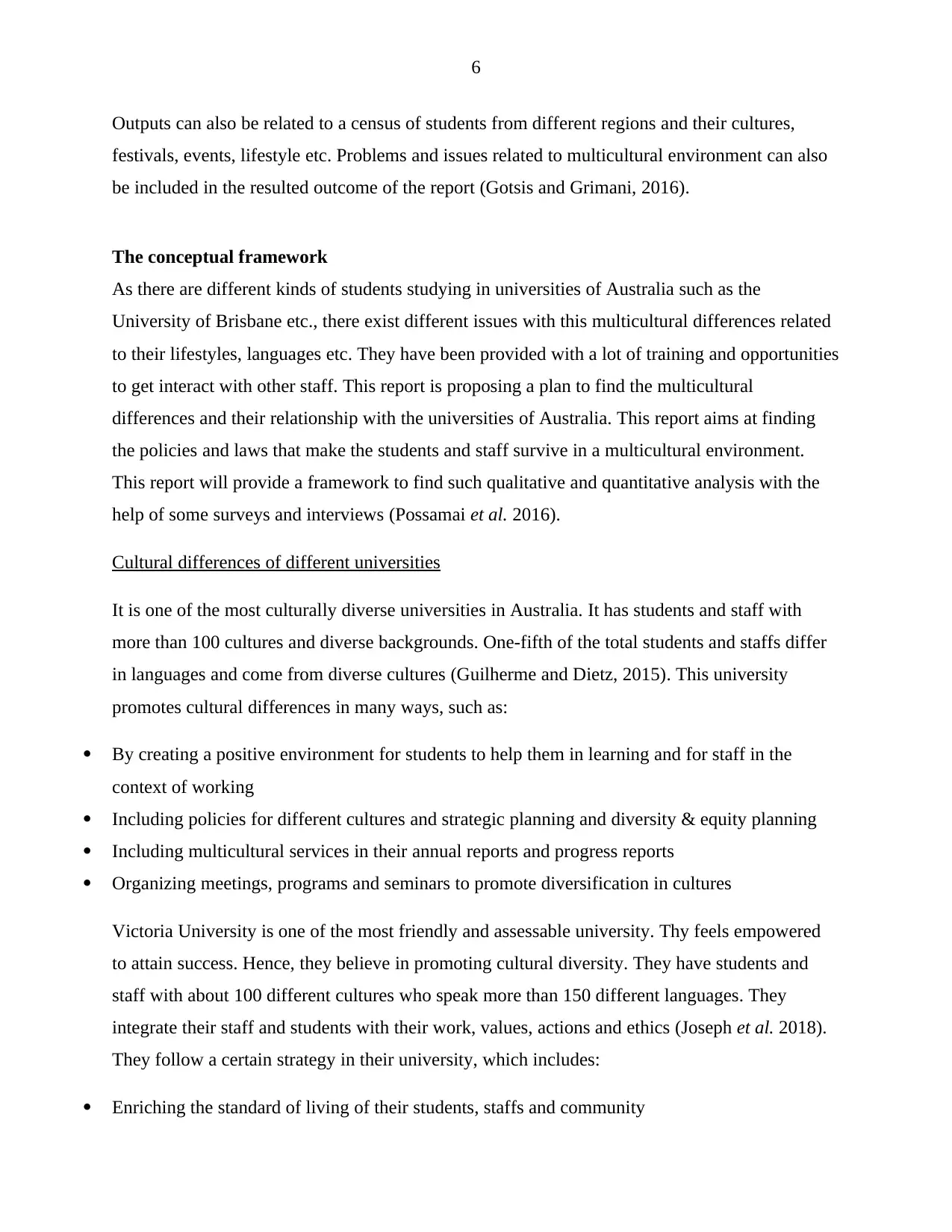
6
Outputs can also be related to a census of students from different regions and their cultures,
festivals, events, lifestyle etc. Problems and issues related to multicultural environment can also
be included in the resulted outcome of the report (Gotsis and Grimani, 2016).
The conceptual framework
As there are different kinds of students studying in universities of Australia such as the
University of Brisbane etc., there exist different issues with this multicultural differences related
to their lifestyles, languages etc. They have been provided with a lot of training and opportunities
to get interact with other staff. This report is proposing a plan to find the multicultural
differences and their relationship with the universities of Australia. This report aims at finding
the policies and laws that make the students and staff survive in a multicultural environment.
This report will provide a framework to find such qualitative and quantitative analysis with the
help of some surveys and interviews (Possamai et al. 2016).
Cultural differences of different universities
It is one of the most culturally diverse universities in Australia. It has students and staff with
more than 100 cultures and diverse backgrounds. One-fifth of the total students and staffs differ
in languages and come from diverse cultures (Guilherme and Dietz, 2015). This university
promotes cultural differences in many ways, such as:
By creating a positive environment for students to help them in learning and for staff in the
context of working
Including policies for different cultures and strategic planning and diversity & equity planning
Including multicultural services in their annual reports and progress reports
Organizing meetings, programs and seminars to promote diversification in cultures
Victoria University is one of the most friendly and assessable university. Thy feels empowered
to attain success. Hence, they believe in promoting cultural diversity. They have students and
staff with about 100 different cultures who speak more than 150 different languages. They
integrate their staff and students with their work, values, actions and ethics (Joseph et al. 2018).
They follow a certain strategy in their university, which includes:
Enriching the standard of living of their students, staffs and community
Outputs can also be related to a census of students from different regions and their cultures,
festivals, events, lifestyle etc. Problems and issues related to multicultural environment can also
be included in the resulted outcome of the report (Gotsis and Grimani, 2016).
The conceptual framework
As there are different kinds of students studying in universities of Australia such as the
University of Brisbane etc., there exist different issues with this multicultural differences related
to their lifestyles, languages etc. They have been provided with a lot of training and opportunities
to get interact with other staff. This report is proposing a plan to find the multicultural
differences and their relationship with the universities of Australia. This report aims at finding
the policies and laws that make the students and staff survive in a multicultural environment.
This report will provide a framework to find such qualitative and quantitative analysis with the
help of some surveys and interviews (Possamai et al. 2016).
Cultural differences of different universities
It is one of the most culturally diverse universities in Australia. It has students and staff with
more than 100 cultures and diverse backgrounds. One-fifth of the total students and staffs differ
in languages and come from diverse cultures (Guilherme and Dietz, 2015). This university
promotes cultural differences in many ways, such as:
By creating a positive environment for students to help them in learning and for staff in the
context of working
Including policies for different cultures and strategic planning and diversity & equity planning
Including multicultural services in their annual reports and progress reports
Organizing meetings, programs and seminars to promote diversification in cultures
Victoria University is one of the most friendly and assessable university. Thy feels empowered
to attain success. Hence, they believe in promoting cultural diversity. They have students and
staff with about 100 different cultures who speak more than 150 different languages. They
integrate their staff and students with their work, values, actions and ethics (Joseph et al. 2018).
They follow a certain strategy in their university, which includes:
Enriching the standard of living of their students, staffs and community
⊘ This is a preview!⊘
Do you want full access?
Subscribe today to unlock all pages.

Trusted by 1+ million students worldwide
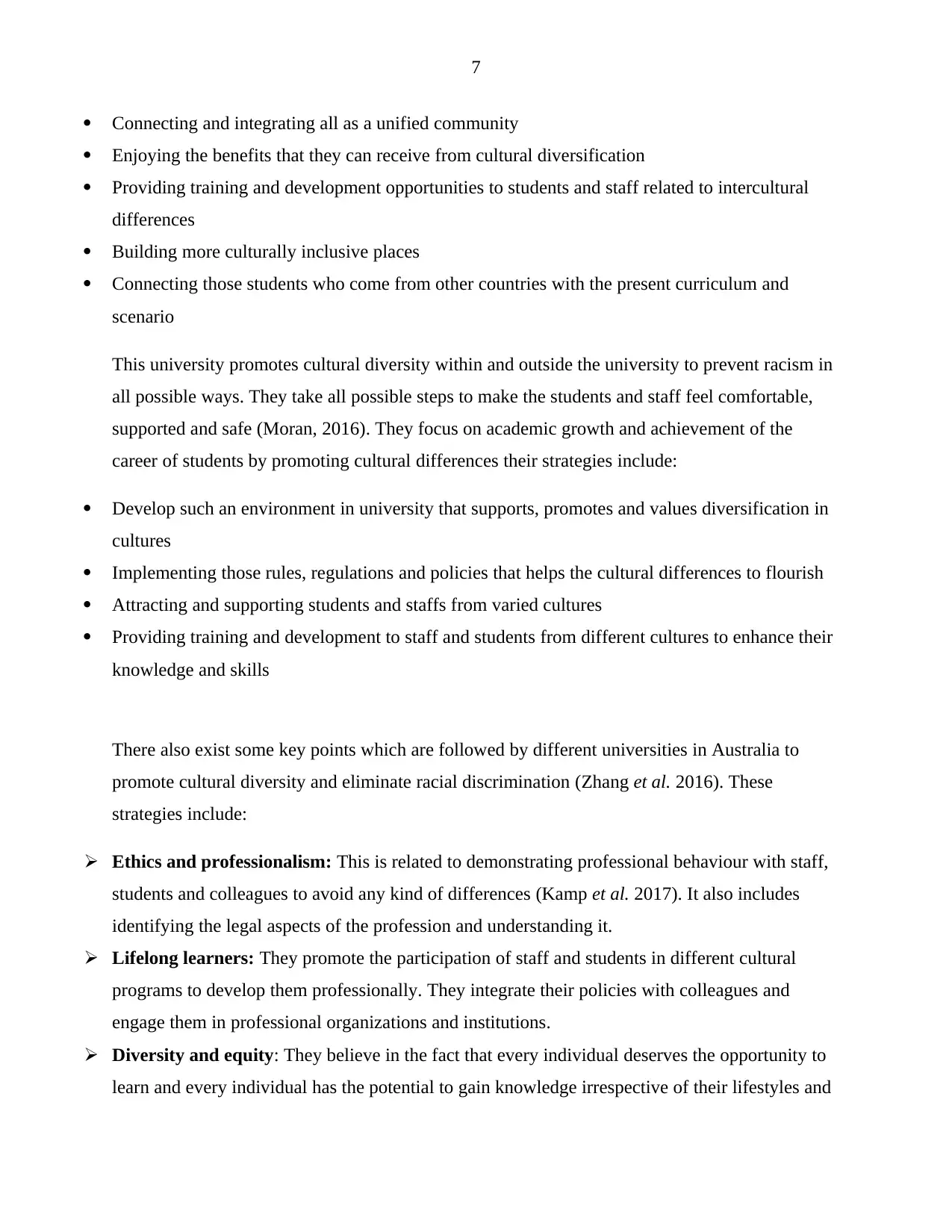
7
Connecting and integrating all as a unified community
Enjoying the benefits that they can receive from cultural diversification
Providing training and development opportunities to students and staff related to intercultural
differences
Building more culturally inclusive places
Connecting those students who come from other countries with the present curriculum and
scenario
This university promotes cultural diversity within and outside the university to prevent racism in
all possible ways. They take all possible steps to make the students and staff feel comfortable,
supported and safe (Moran, 2016). They focus on academic growth and achievement of the
career of students by promoting cultural differences their strategies include:
Develop such an environment in university that supports, promotes and values diversification in
cultures
Implementing those rules, regulations and policies that helps the cultural differences to flourish
Attracting and supporting students and staffs from varied cultures
Providing training and development to staff and students from different cultures to enhance their
knowledge and skills
There also exist some key points which are followed by different universities in Australia to
promote cultural diversity and eliminate racial discrimination (Zhang et al. 2016). These
strategies include:
Ethics and professionalism: This is related to demonstrating professional behaviour with staff,
students and colleagues to avoid any kind of differences (Kamp et al. 2017). It also includes
identifying the legal aspects of the profession and understanding it.
Lifelong learners: They promote the participation of staff and students in different cultural
programs to develop them professionally. They integrate their policies with colleagues and
engage them in professional organizations and institutions.
Diversity and equity: They believe in the fact that every individual deserves the opportunity to
learn and every individual has the potential to gain knowledge irrespective of their lifestyles and
Connecting and integrating all as a unified community
Enjoying the benefits that they can receive from cultural diversification
Providing training and development opportunities to students and staff related to intercultural
differences
Building more culturally inclusive places
Connecting those students who come from other countries with the present curriculum and
scenario
This university promotes cultural diversity within and outside the university to prevent racism in
all possible ways. They take all possible steps to make the students and staff feel comfortable,
supported and safe (Moran, 2016). They focus on academic growth and achievement of the
career of students by promoting cultural differences their strategies include:
Develop such an environment in university that supports, promotes and values diversification in
cultures
Implementing those rules, regulations and policies that helps the cultural differences to flourish
Attracting and supporting students and staffs from varied cultures
Providing training and development to staff and students from different cultures to enhance their
knowledge and skills
There also exist some key points which are followed by different universities in Australia to
promote cultural diversity and eliminate racial discrimination (Zhang et al. 2016). These
strategies include:
Ethics and professionalism: This is related to demonstrating professional behaviour with staff,
students and colleagues to avoid any kind of differences (Kamp et al. 2017). It also includes
identifying the legal aspects of the profession and understanding it.
Lifelong learners: They promote the participation of staff and students in different cultural
programs to develop them professionally. They integrate their policies with colleagues and
engage them in professional organizations and institutions.
Diversity and equity: They believe in the fact that every individual deserves the opportunity to
learn and every individual has the potential to gain knowledge irrespective of their lifestyles and
Paraphrase This Document
Need a fresh take? Get an instant paraphrase of this document with our AI Paraphraser
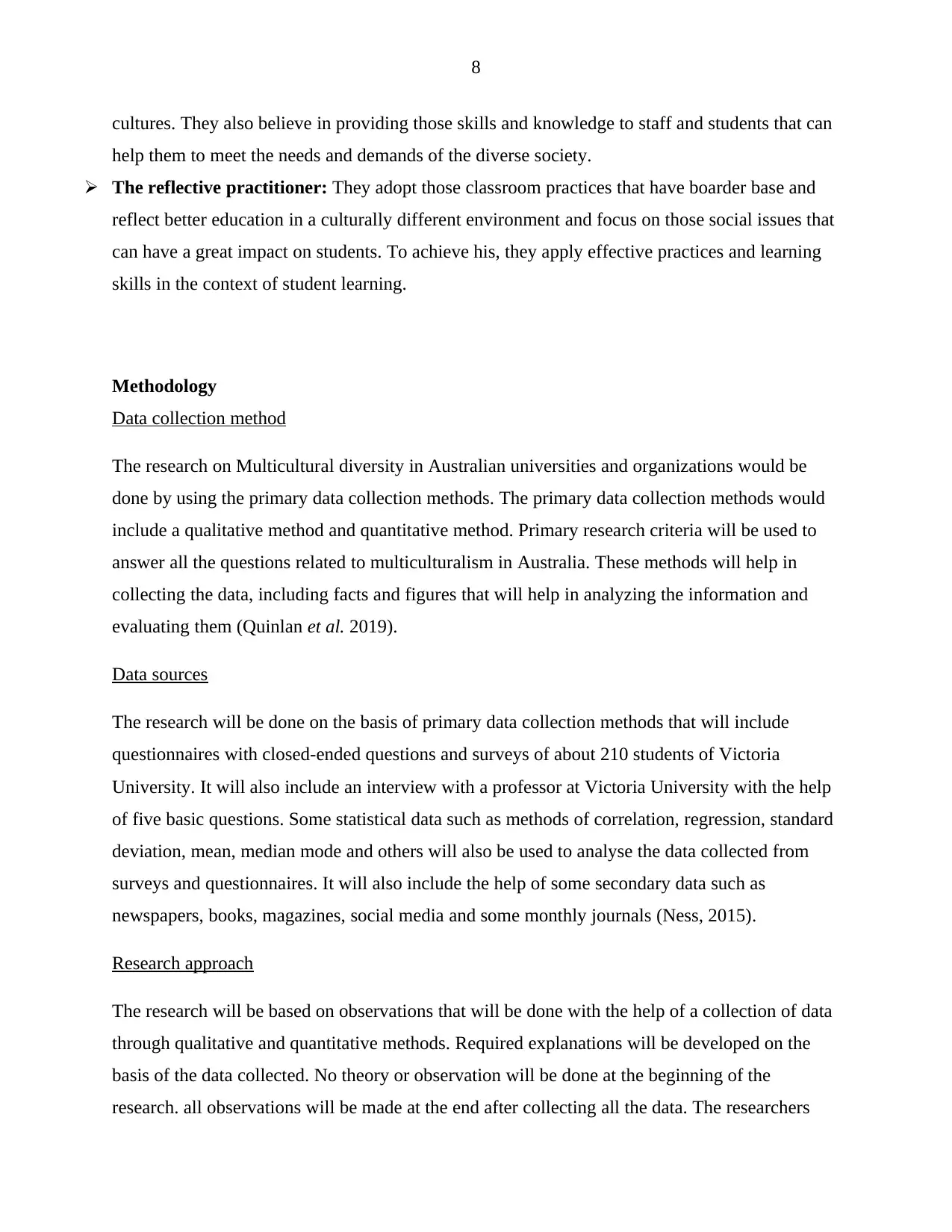
8
cultures. They also believe in providing those skills and knowledge to staff and students that can
help them to meet the needs and demands of the diverse society.
The reflective practitioner: They adopt those classroom practices that have boarder base and
reflect better education in a culturally different environment and focus on those social issues that
can have a great impact on students. To achieve his, they apply effective practices and learning
skills in the context of student learning.
Methodology
Data collection method
The research on Multicultural diversity in Australian universities and organizations would be
done by using the primary data collection methods. The primary data collection methods would
include a qualitative method and quantitative method. Primary research criteria will be used to
answer all the questions related to multiculturalism in Australia. These methods will help in
collecting the data, including facts and figures that will help in analyzing the information and
evaluating them (Quinlan et al. 2019).
Data sources
The research will be done on the basis of primary data collection methods that will include
questionnaires with closed-ended questions and surveys of about 210 students of Victoria
University. It will also include an interview with a professor at Victoria University with the help
of five basic questions. Some statistical data such as methods of correlation, regression, standard
deviation, mean, median mode and others will also be used to analyse the data collected from
surveys and questionnaires. It will also include the help of some secondary data such as
newspapers, books, magazines, social media and some monthly journals (Ness, 2015).
Research approach
The research will be based on observations that will be done with the help of a collection of data
through qualitative and quantitative methods. Required explanations will be developed on the
basis of the data collected. No theory or observation will be done at the beginning of the
research. all observations will be made at the end after collecting all the data. The researchers
cultures. They also believe in providing those skills and knowledge to staff and students that can
help them to meet the needs and demands of the diverse society.
The reflective practitioner: They adopt those classroom practices that have boarder base and
reflect better education in a culturally different environment and focus on those social issues that
can have a great impact on students. To achieve his, they apply effective practices and learning
skills in the context of student learning.
Methodology
Data collection method
The research on Multicultural diversity in Australian universities and organizations would be
done by using the primary data collection methods. The primary data collection methods would
include a qualitative method and quantitative method. Primary research criteria will be used to
answer all the questions related to multiculturalism in Australia. These methods will help in
collecting the data, including facts and figures that will help in analyzing the information and
evaluating them (Quinlan et al. 2019).
Data sources
The research will be done on the basis of primary data collection methods that will include
questionnaires with closed-ended questions and surveys of about 210 students of Victoria
University. It will also include an interview with a professor at Victoria University with the help
of five basic questions. Some statistical data such as methods of correlation, regression, standard
deviation, mean, median mode and others will also be used to analyse the data collected from
surveys and questionnaires. It will also include the help of some secondary data such as
newspapers, books, magazines, social media and some monthly journals (Ness, 2015).
Research approach
The research will be based on observations that will be done with the help of a collection of data
through qualitative and quantitative methods. Required explanations will be developed on the
basis of the data collected. No theory or observation will be done at the beginning of the
research. all observations will be made at the end after collecting all the data. The researchers
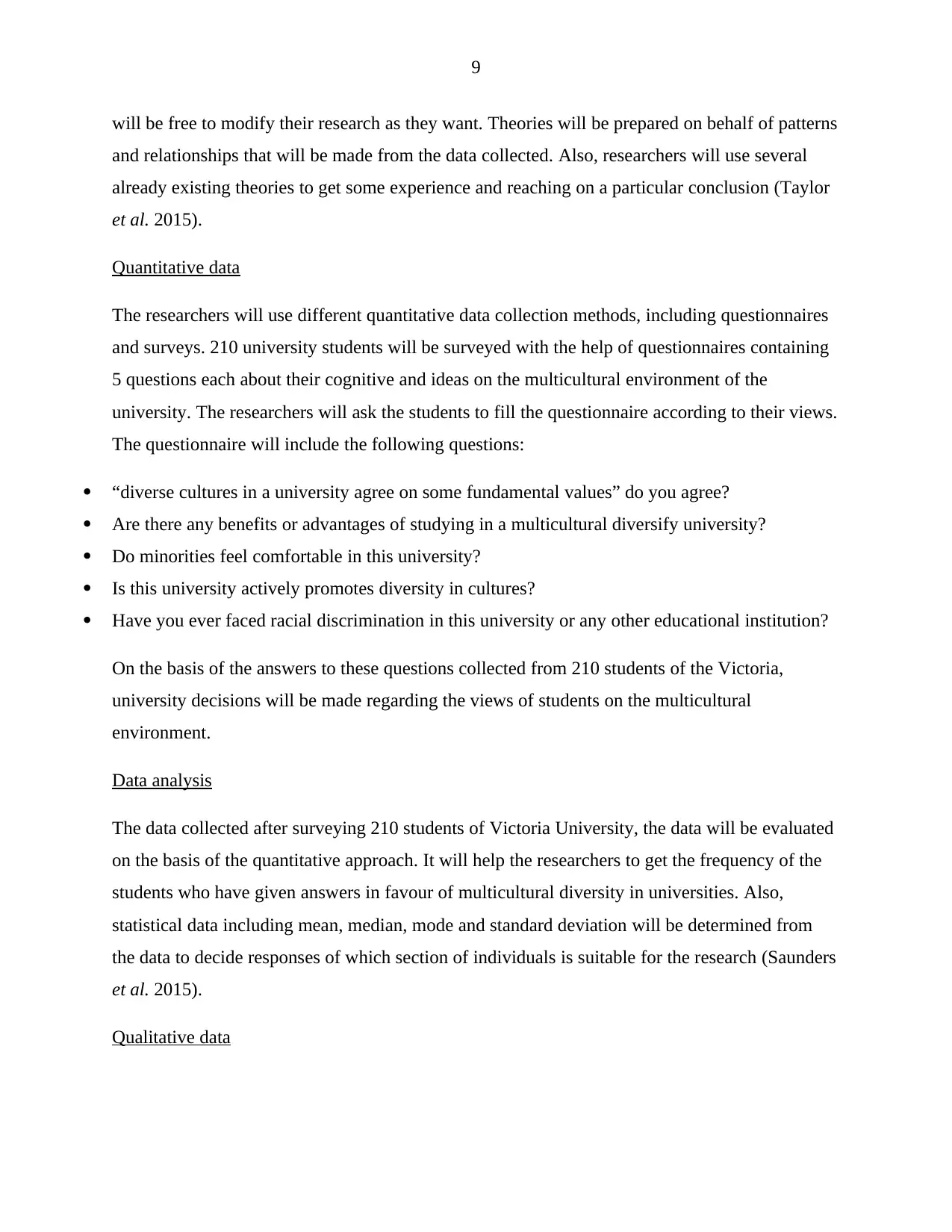
9
will be free to modify their research as they want. Theories will be prepared on behalf of patterns
and relationships that will be made from the data collected. Also, researchers will use several
already existing theories to get some experience and reaching on a particular conclusion (Taylor
et al. 2015).
Quantitative data
The researchers will use different quantitative data collection methods, including questionnaires
and surveys. 210 university students will be surveyed with the help of questionnaires containing
5 questions each about their cognitive and ideas on the multicultural environment of the
university. The researchers will ask the students to fill the questionnaire according to their views.
The questionnaire will include the following questions:
“diverse cultures in a university agree on some fundamental values” do you agree?
Are there any benefits or advantages of studying in a multicultural diversify university?
Do minorities feel comfortable in this university?
Is this university actively promotes diversity in cultures?
Have you ever faced racial discrimination in this university or any other educational institution?
On the basis of the answers to these questions collected from 210 students of the Victoria,
university decisions will be made regarding the views of students on the multicultural
environment.
Data analysis
The data collected after surveying 210 students of Victoria University, the data will be evaluated
on the basis of the quantitative approach. It will help the researchers to get the frequency of the
students who have given answers in favour of multicultural diversity in universities. Also,
statistical data including mean, median, mode and standard deviation will be determined from
the data to decide responses of which section of individuals is suitable for the research (Saunders
et al. 2015).
Qualitative data
will be free to modify their research as they want. Theories will be prepared on behalf of patterns
and relationships that will be made from the data collected. Also, researchers will use several
already existing theories to get some experience and reaching on a particular conclusion (Taylor
et al. 2015).
Quantitative data
The researchers will use different quantitative data collection methods, including questionnaires
and surveys. 210 university students will be surveyed with the help of questionnaires containing
5 questions each about their cognitive and ideas on the multicultural environment of the
university. The researchers will ask the students to fill the questionnaire according to their views.
The questionnaire will include the following questions:
“diverse cultures in a university agree on some fundamental values” do you agree?
Are there any benefits or advantages of studying in a multicultural diversify university?
Do minorities feel comfortable in this university?
Is this university actively promotes diversity in cultures?
Have you ever faced racial discrimination in this university or any other educational institution?
On the basis of the answers to these questions collected from 210 students of the Victoria,
university decisions will be made regarding the views of students on the multicultural
environment.
Data analysis
The data collected after surveying 210 students of Victoria University, the data will be evaluated
on the basis of the quantitative approach. It will help the researchers to get the frequency of the
students who have given answers in favour of multicultural diversity in universities. Also,
statistical data including mean, median, mode and standard deviation will be determined from
the data to decide responses of which section of individuals is suitable for the research (Saunders
et al. 2015).
Qualitative data
⊘ This is a preview!⊘
Do you want full access?
Subscribe today to unlock all pages.

Trusted by 1+ million students worldwide
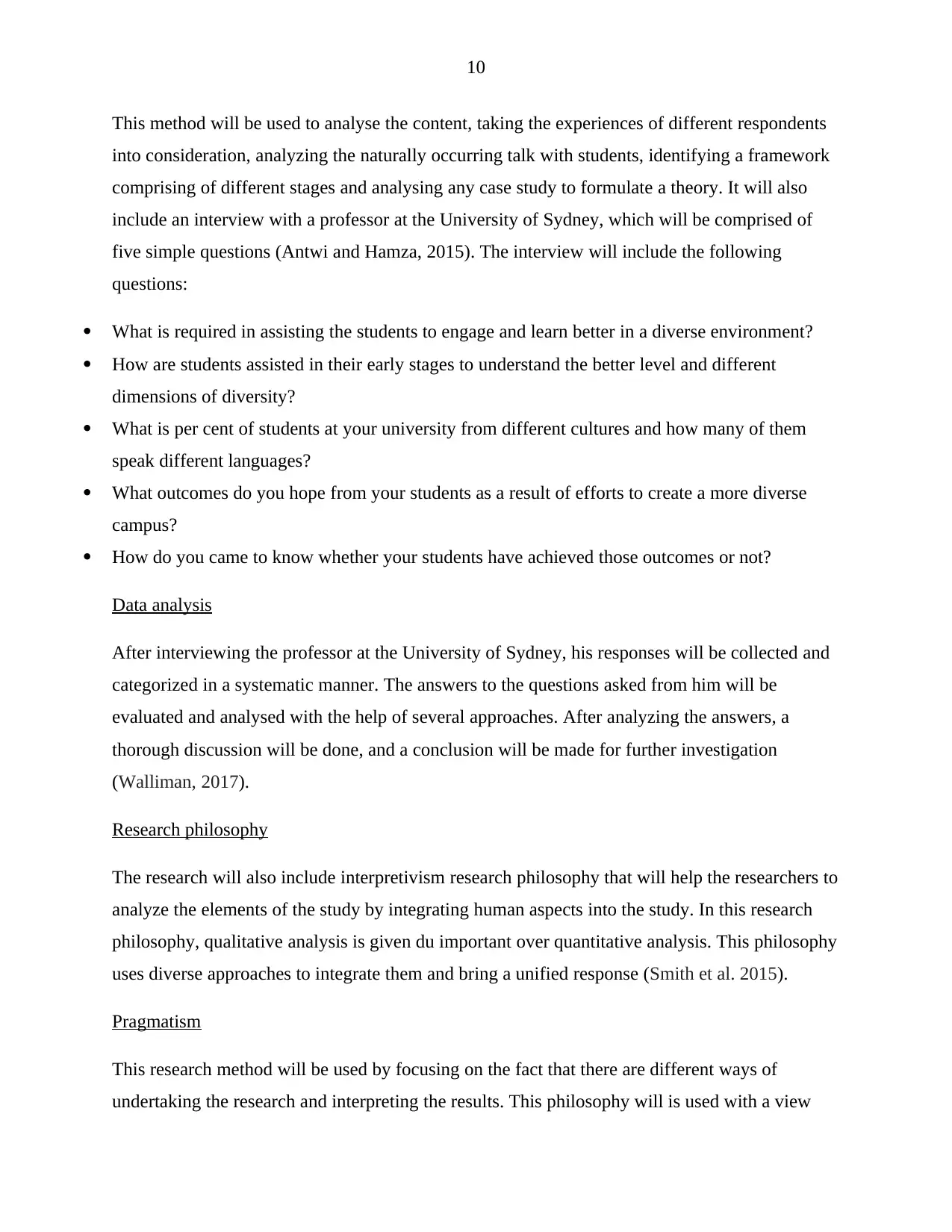
10
This method will be used to analyse the content, taking the experiences of different respondents
into consideration, analyzing the naturally occurring talk with students, identifying a framework
comprising of different stages and analysing any case study to formulate a theory. It will also
include an interview with a professor at the University of Sydney, which will be comprised of
five simple questions (Antwi and Hamza, 2015). The interview will include the following
questions:
What is required in assisting the students to engage and learn better in a diverse environment?
How are students assisted in their early stages to understand the better level and different
dimensions of diversity?
What is per cent of students at your university from different cultures and how many of them
speak different languages?
What outcomes do you hope from your students as a result of efforts to create a more diverse
campus?
How do you came to know whether your students have achieved those outcomes or not?
Data analysis
After interviewing the professor at the University of Sydney, his responses will be collected and
categorized in a systematic manner. The answers to the questions asked from him will be
evaluated and analysed with the help of several approaches. After analyzing the answers, a
thorough discussion will be done, and a conclusion will be made for further investigation
(Walliman, 2017).
Research philosophy
The research will also include interpretivism research philosophy that will help the researchers to
analyze the elements of the study by integrating human aspects into the study. In this research
philosophy, qualitative analysis is given du important over quantitative analysis. This philosophy
uses diverse approaches to integrate them and bring a unified response (Smith et al. 2015).
Pragmatism
This research method will be used by focusing on the fact that there are different ways of
undertaking the research and interpreting the results. This philosophy will is used with a view
This method will be used to analyse the content, taking the experiences of different respondents
into consideration, analyzing the naturally occurring talk with students, identifying a framework
comprising of different stages and analysing any case study to formulate a theory. It will also
include an interview with a professor at the University of Sydney, which will be comprised of
five simple questions (Antwi and Hamza, 2015). The interview will include the following
questions:
What is required in assisting the students to engage and learn better in a diverse environment?
How are students assisted in their early stages to understand the better level and different
dimensions of diversity?
What is per cent of students at your university from different cultures and how many of them
speak different languages?
What outcomes do you hope from your students as a result of efforts to create a more diverse
campus?
How do you came to know whether your students have achieved those outcomes or not?
Data analysis
After interviewing the professor at the University of Sydney, his responses will be collected and
categorized in a systematic manner. The answers to the questions asked from him will be
evaluated and analysed with the help of several approaches. After analyzing the answers, a
thorough discussion will be done, and a conclusion will be made for further investigation
(Walliman, 2017).
Research philosophy
The research will also include interpretivism research philosophy that will help the researchers to
analyze the elements of the study by integrating human aspects into the study. In this research
philosophy, qualitative analysis is given du important over quantitative analysis. This philosophy
uses diverse approaches to integrate them and bring a unified response (Smith et al. 2015).
Pragmatism
This research method will be used by focusing on the fact that there are different ways of
undertaking the research and interpreting the results. This philosophy will is used with a view
Paraphrase This Document
Need a fresh take? Get an instant paraphrase of this document with our AI Paraphraser
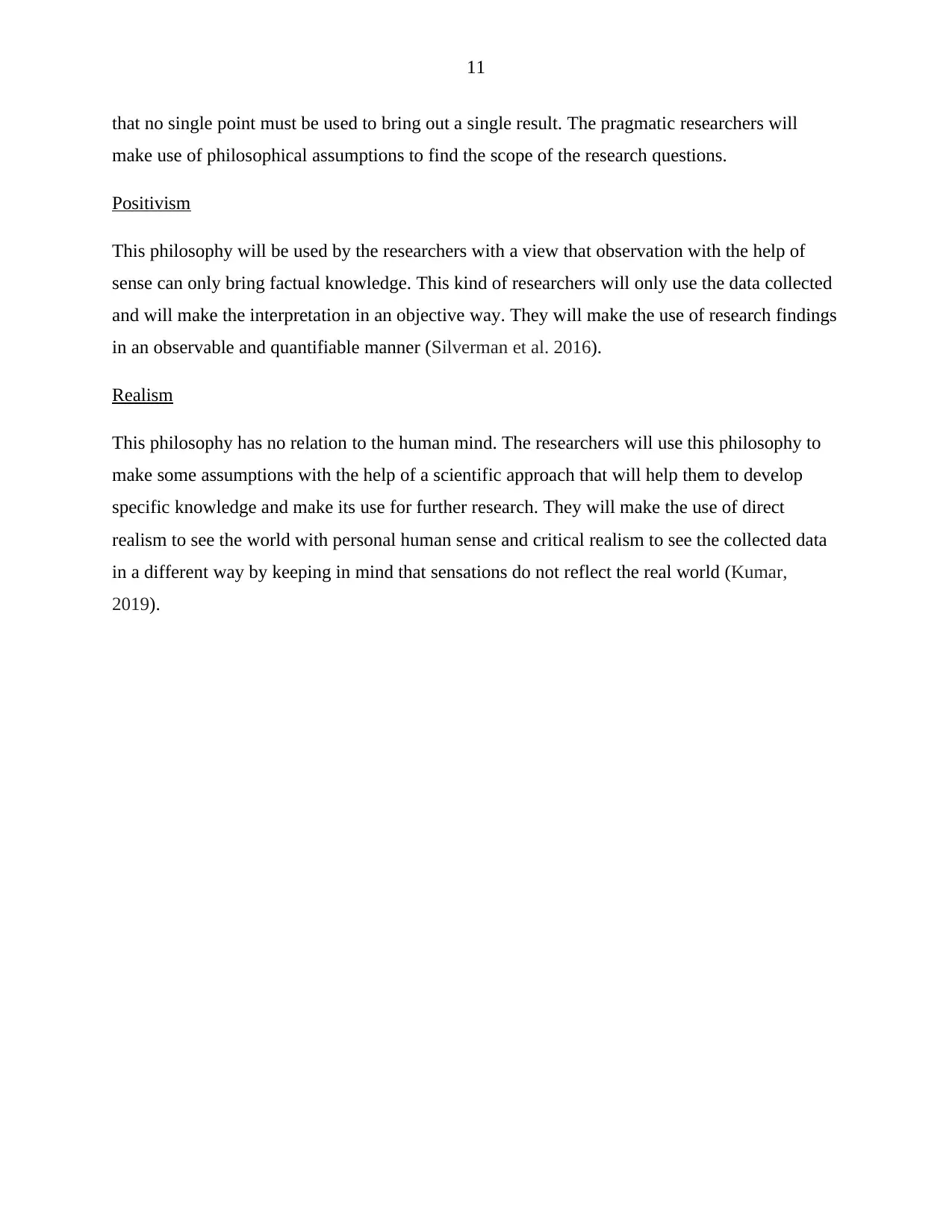
11
that no single point must be used to bring out a single result. The pragmatic researchers will
make use of philosophical assumptions to find the scope of the research questions.
Positivism
This philosophy will be used by the researchers with a view that observation with the help of
sense can only bring factual knowledge. This kind of researchers will only use the data collected
and will make the interpretation in an objective way. They will make the use of research findings
in an observable and quantifiable manner (Silverman et al. 2016).
Realism
This philosophy has no relation to the human mind. The researchers will use this philosophy to
make some assumptions with the help of a scientific approach that will help them to develop
specific knowledge and make its use for further research. They will make the use of direct
realism to see the world with personal human sense and critical realism to see the collected data
in a different way by keeping in mind that sensations do not reflect the real world (Kumar,
2019).
that no single point must be used to bring out a single result. The pragmatic researchers will
make use of philosophical assumptions to find the scope of the research questions.
Positivism
This philosophy will be used by the researchers with a view that observation with the help of
sense can only bring factual knowledge. This kind of researchers will only use the data collected
and will make the interpretation in an objective way. They will make the use of research findings
in an observable and quantifiable manner (Silverman et al. 2016).
Realism
This philosophy has no relation to the human mind. The researchers will use this philosophy to
make some assumptions with the help of a scientific approach that will help them to develop
specific knowledge and make its use for further research. They will make the use of direct
realism to see the world with personal human sense and critical realism to see the collected data
in a different way by keeping in mind that sensations do not reflect the real world (Kumar,
2019).
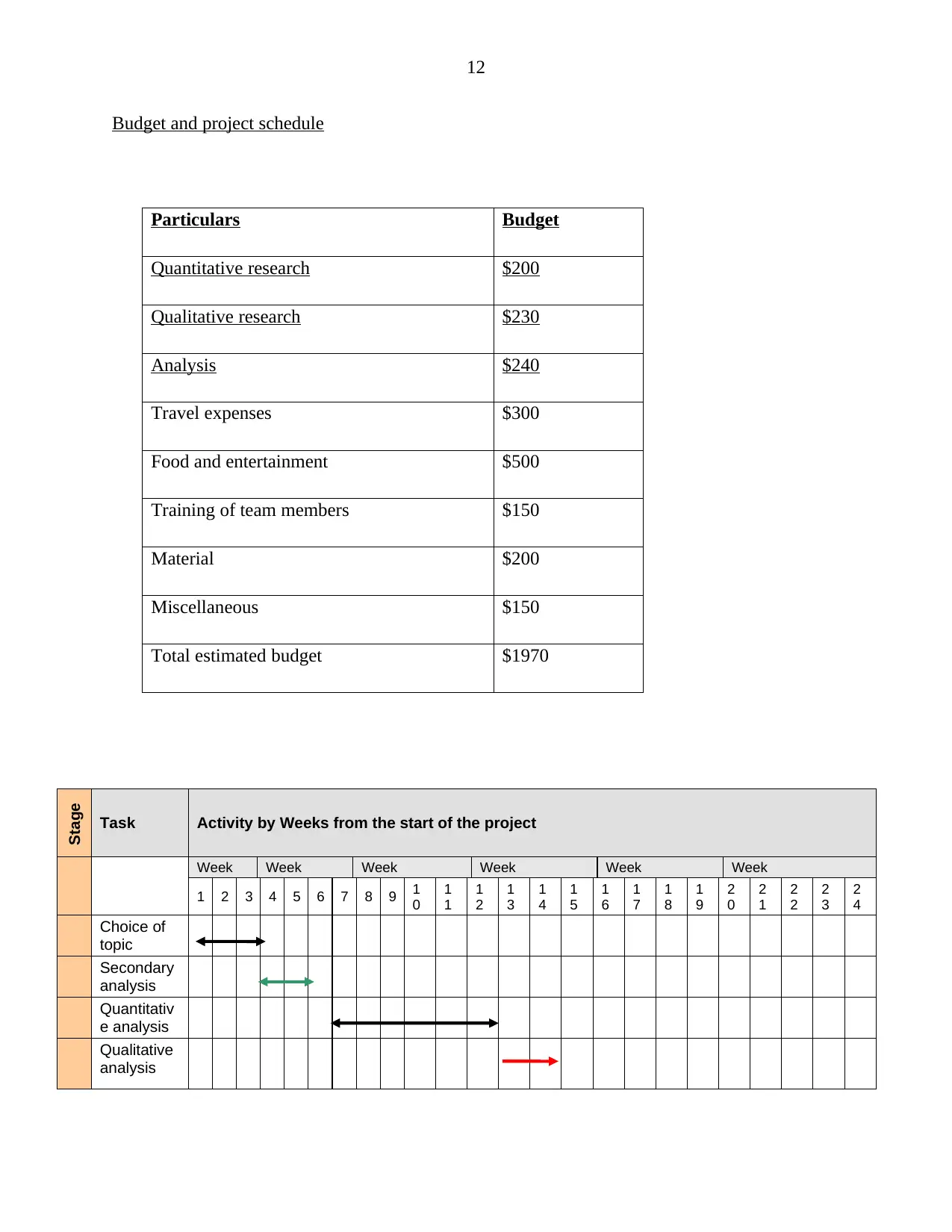
12
Budget and project schedule
Particulars Budget
Quantitative research $200
Qualitative research $230
Analysis $240
Travel expenses $300
Food and entertainment $500
Training of team members $150
Material $200
Miscellaneous $150
Total estimated budget $1970
Stage
Task Activity by Weeks from the start of the project
Week Week Week Week Week Week
1 2 3 4 5 6 7 8 9 1
0
1
1
1
2
1
3
1
4
1
5
1
6
1
7
1
8
1
9
2
0
2
1
2
2
2
3
2
4
Choice of
topic
Secondary
analysis
Quantitativ
e analysis
Qualitative
analysis
Budget and project schedule
Particulars Budget
Quantitative research $200
Qualitative research $230
Analysis $240
Travel expenses $300
Food and entertainment $500
Training of team members $150
Material $200
Miscellaneous $150
Total estimated budget $1970
Stage
Task Activity by Weeks from the start of the project
Week Week Week Week Week Week
1 2 3 4 5 6 7 8 9 1
0
1
1
1
2
1
3
1
4
1
5
1
6
1
7
1
8
1
9
2
0
2
1
2
2
2
3
2
4
Choice of
topic
Secondary
analysis
Quantitativ
e analysis
Qualitative
analysis
⊘ This is a preview!⊘
Do you want full access?
Subscribe today to unlock all pages.

Trusted by 1+ million students worldwide
1 out of 17
Related Documents
Your All-in-One AI-Powered Toolkit for Academic Success.
+13062052269
info@desklib.com
Available 24*7 on WhatsApp / Email
![[object Object]](/_next/static/media/star-bottom.7253800d.svg)
Unlock your academic potential
Copyright © 2020–2025 A2Z Services. All Rights Reserved. Developed and managed by ZUCOL.





